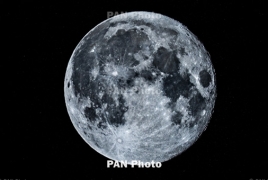Moon could host more sub-surface water reserves than thought July 25, 2017 - 11:16 AMT PanARMENIAN.Net - The Moon, long thought to be a dry, inhospitable orb, hosts surprisingly large sub-surface water reserves, which one day may quench the thirst of lunar explorers from Earth, scientists said Monday, July 24, according to AFP. "We found the signature of the lunar interior water globally using satellite data," Shuai Li, co-author of a study by scientists at Brown University in the United States, told AFP. "Such water can be used as in situ resources for future exploration," said Li, a postdoctoral researcher at the University of Hawaii and Brown Ph.D graduate. Li noted scientists had believed the Moon to be "bone dry" until about a decade ago, when scientists found evidence of water -- an essential ingredient for life -- in pebble-like beads brought back by Apollo missions. The Brown findings show numerous volcanic deposits distributed across the surface of the Moon contain "unusually high amounts of trapped water" compared with surrounding terrain. They say discovery of water in the ancient deposits, which are believed to consist of glass beads formed by the explosive eruption of magma from beneath the Moon's surface, boosts the idea that the lunar mantle is surprisingly water-rich. "The key question is whether those Apollo samples represent the bulk conditions of the lunar interior or instead represent unusual or perhaps anomalous water-rich regions within an otherwise 'dry' mantle," said Ralph Milliken, lead author of the new research, published in the Nature Geoscience journal on Monday. "The distribution of these water-rich deposits is the key thing," Milliken said. "They're spread across the surface, which tells us that the water found in the Apollo samples isn’t a one-off," he added. "By looking at the orbital data, we can examine the large pyroclastic deposits on the Moon that were never sampled by the Apollo or (Soviet) Luna missions," said the associate professor at Brown's Department of Earth, Environmental and Planetary Sciences. "The fact that nearly all of them exhibit signatures of water suggests that the Apollo samples are not anomalous, so it may be that the bulk interior of the Moon is wet." Scientists believe the Moon formed from debris left behind after an object about the size of Mars slammed into the Earth early in solar system history. They had assumed it was unlikely that any of the hydrogen needed to form water could have survived the heat of that impact. Authorities said a total of 192 Azerbaijani troops were killed and 511 were wounded during Azerbaijan’s offensive. In 2023, the Azerbaijani government will increase the country’s defense budget by more than 1.1 billion manats ($650 million). The bill, published on Monday, is designed to "eliminate the shortcomings of an unreasonably broad interpretation of the key concept of "compatriot". The earthquake caused a temporary blackout, damaged many buildings and closed a number of rural roads. Partner news |